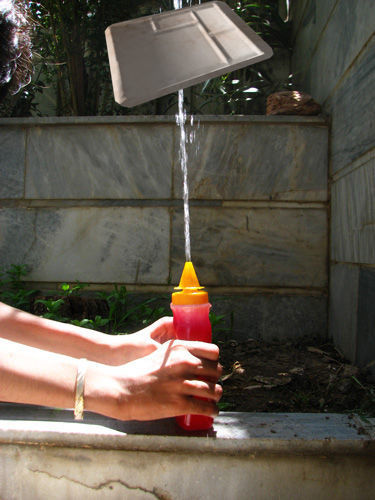Antigravity in the summertime

Summer is coming (for some of us) and you're trying out your new water guns. Your test involves hovering a cafeteria tray in midair by shooting it with a stream of water from your gun. Whichever gun can suspend the tray at the greatest height is the winner.
Suppose your best gun shoots water upward with an initial velocity v 0 , and that the weight of your tray is M , what is the height h max (in meters) at which the tray hovers at rest?
Assumptions and Details
- v 0 = 2 0 m/s
- M = 1 . 5 kg
- The flux of water from the tip of the gun is J m = 0 . 4 5 kg/s
- Take g = 9 . 8 m/s 2
- Assume that the water comes straight down after hitting the tray, i.e. the collision is elastic (practically, this can be achieved if the spray has a slight radial spread as it travels upward).
The answer is 6.79705.
This section requires Javascript.
You are seeing this because something didn't load right. We suggest you, (a) try
refreshing the page, (b) enabling javascript if it is disabled on your browser and,
finally, (c)
loading the
non-javascript version of this page
. We're sorry about the hassle.
2 solutions
To keep the tray floating at rest, net force on tray must be zero. The weight of the tray is W t = M g downwards. The water must provide the same magnitude of force upwards.
If water collides elastically with the tray, then the momentum of water changes at the rate of J m ( v − ( − v ) ) = 2 J m v . Using Newton's third law of motion, water will exert equal and opposite force on tray i.e. 2 J m v force upward. Here v is the velocity at which water collides with tray.
Both forces are equal, so
M g = 2 J m v
⟹ v = 2 J m M g . . . . . . . ( ∗ )
Using laws of kinematics,
v 2 − v 0 2 = 2 ( − g ) h max
⟹ v = v 0 2 − 2 g h max . . . . . . . ( ∗ ∗ )
We use ( ∗ ) and ( ∗ ∗ ) to eliminate v
2 J m M g = v 0 2 − 2 g h max
We make h max the subject of the formula.
h max = 2 g v 0 2 − ( 2 J m M g ) 2
When we substitute the values, we get h max ≈ 6 . 7 9 7 m □
Why should J m remain constant with height?
Log in to reply
Because (we assume that) water is not lost anywhere, before hitting the tray. This is the very same thing that leads to the equation of continuity for fluid flow. I believe that the water slowing down as it goes up made you ask this question. In reality, the water does slow down, but the radius of the water jet increases with height too. This ensures that the flux is same at all heights.
Incidentally, this law of kinematic is only from K.E.=P.E. for same mass.
@Josh Silverman ok for this question it didn't say that the water fell back at the same velocity that it was shot at right, so how can we assume its 2J
Velocity of water at the maximum height equals
v 2 = v 0 2 − 2 g h m a x ....... (1)
Now force provided by water stream should balance the weight of tray
Change in momemtum of stream = Mg
J ( v − ( − v ) ) = M g
v = 2 J M g
Substituting in equation (1)
( 2 J M g ) 2 = v 0 2 − 2 g h m a x
Substituting given values in the equation to get
h m a x = 6 . 7 9 7 m